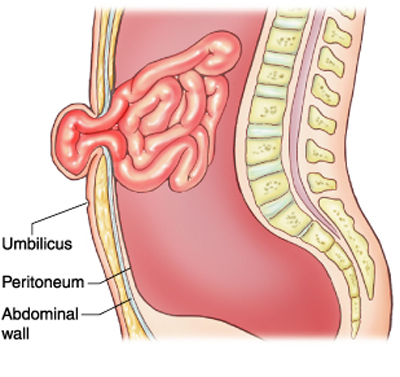
What is a hernia?
What is a hernia?
A hernia is a hole in the abdominal wall. This hole allows the protrusion of a structure that is supposed to be within the abdomen. The structure that protrudes can be some fat, a loop of intestine, the appendix, an ovary, or part of the bladder. Hernias of the abdominal wall are one of the most common conditions requiring surgery. You can think of a hernia like an inner tube of a tire that is protruding out of the outer tread which is worn out.
Hernias can occur in men and women of all ages and in children. Some hernias are present at birth. Others develop slowly over a period of months or years.
Why do hernias develop?
Hernias commonly develop in an area of weakness including natural spaces and thin tissue, such as the internal inguinal ring and the floor of the inguinal canal. Hernias may develop at these sites or other areas due to aging, injury, an old incision, or a weakness present at birth.
Another important factor in the development of hernias is an increase in the intra-abdominal pressure. This could be secondary to chronic constipation and prolonged straining, chronic persistent coughing, lifting heavy objects, pregnancy, obesity, or chronic liver disease.
What are the different types of hernias?
Inguinal hernias are in the groin area. They are most common in men, primarily because of the unsupported space left in the groin after the testicles descend into the scrotum. Inguinal hernias can be indirect: the hernia sac exits through the internal inguinal ring and takes an oblique path; or direct: the hernia sac exits through the external inguinal ring directly.
Femoral hernias occur at the top of the thigh in the space through which the femoral artery, vein, and nerve pass into the thigh. These hernias occur most often in women.
Umbilical hernias occur in the umbilicus (belly button). They are usually congenital hernias (present since birth).
Incisional hernias occur at the site of previous abdominal surgery.
What symptoms do hernias cause?
Some patients with hernias are unaware of their presence until the hernias are pointed out to them. The patient may notice a bulge under the skin without any associated symptoms.
When hernias do cause symptoms, the symptoms can be variable in quality and intensity. Discomfort can be related to the contents of the hernia sac or pressure of the sac on the surrounding tissue. Patients may experience pain when lifting a heavy object, coughing, or straining during urination or bowel movement.
In some cases the pain is a dull ache that gets worse towards the end of the day after standing for long periods of time and is relieved at night when you lie down and the hernia reduces (goes back in).
Most hernias are reducible. The contents of the hernia sac can be squeezed back into the abdominal cavity without difficulty. If the hernia remains bulging for a long time or the contents of the hernia are crowded, then it may be difficult to reduce the hernia. This is an incarcerated hernia.
If the hernia continues to be incarcerated (trapped) for some time then the contents of the hernia, which is most commonly bowel, will become swollen and there will be compromise of the blood supply to the bowel. This is called a strangulated hernia and is a surgical emergency. A hernia that strangulates produces intense pain in the hernia followed by marked tenderness. Because of intestinal obstruction, there is abdominal pain and vomiting.
How is a hernia diagnosed?
Hernias are usually easy to diagnose on physical examination. Typically, a hernia sac with its contents enlarges and transmits a palpable impulse when the patient strains or coughs. Hernias, undetectable by physical examination, can sometimes be demonstrated using ultrasound, CT scan (computerized tomography), or MRI (nuclear magnetic resonance imaging).
None of these tests are as sensitive as physical examination. The most sensitive method of diagnosing a hernia is a diagnostic laparoscopy. This procedure, done under general anesthesia, utilizes a scope placed into the abdominal cavity to directly view the abdominal wall.
Do hernias ever resolve without surgery?
No. A hernia is a mechanical defect that the body cannot repair. Since the defect in the abdominal wall is a defect in the connective tissue of the abdomen (called fascia), strengthening the abdominal wall musculature with exercise does not repair the hernia. In patients who are at high risk for surgery sometimes a trus or support is used to minimize the symptoms of the hernia. These devices are not curative but only attempt to control symptoms in patients that cannot have their hernias fixed.
Why fix a hernia with surgery?
Hernias are fixed with surgery both to eliminate pain and to correct or prevent a dangerous strangulated hernia.
Year to year the risk of strangulation is small, however if the patient has a reasonable life expectancy this risk will add up to a significant risk over the patient’s lifetime. For this reason even hernias that are not causing symptoms should be repaired unless there are other conditions in the patient that preclude a safe outcome or the patient has a limited life expectancy.
Trusses and surgical belts are helpful in the management of symptoms, but probably do not significantly alter the risk of strangulation.
Hernia Surgery
There are many techniques used to repair hernias. For groin hernias and many incisional hernias Dr. Fusco recommends the laparoscopic technique. For umbilical hernias Dr. Fusco usually recommends a direct suture repair for small defects. For larger defects prosthetic mesh repair is used often utilizing a Bard Perfix plug technique.®